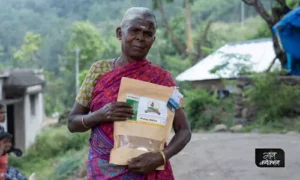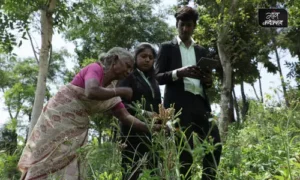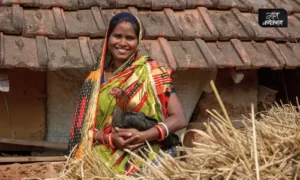March is one of the most hectic months for Lakshmi Devi who finds herself occupied with frying sweet and salty snacks for her five children — a frenzy which begins at least a week before the Holi festival.
But this year, Lakshmi is sitting idle, worried about making both ends meet.
“After two years, which got ruined due to Corona, we were hoping to celebrate this Holi with much excitement but mehengaayi (inflation) has spoiled our plans,” Lakshmi, a resident of Belhara village in Uttar Pradesh’s Barabanki district told Gaon Connection. “I won’t be cooking the snacks much as every ingredient is so expensive! Right from flour and oil to vegetables everything is so costly that I cannot afford to celebrate Holi,” she added.
The 30-year-old works as a labourer at construction sites in and around her village, and her husband runs a small business selling panipuri (an Indian snack eaten with spiced water) on a bicycle.

Lakshmi Devi
“Even my husband’s business is not doing well as he had to increase the price of panipuri due to costlier oil as a result few people visit his shop now. Mehengaayi has impacted the entire Belhara village,” she added.
The worries of Lakshmi and her husband are not unfounded as the Union Ministry of Commerce and Industries announced on March 14 that the wholesale price index (WPI — a measure of the inflation rate in the wholesale markets) has soared to 13.11 per cent in February 2022.
The WPI data also informed that the inflation is mainly driven by higher food prices and vegetables, cereals, oil seeds and crude oil. The WPI inflation for vegetables soared to 26.93 per cent, oilseeds by 22.88 per cent, wheat by 11.03 per cent and crude oil by 46.14 per cent.

Usually, Belhara village’s population of almost 15,000 people takes little interest in the geopolitical events which trend on social media and contribute a fair share to the global news headlines but when Gaon Connection questioned the Belhara residents about what they think has spiked the prices of essential commodities, almost every adult responded with mention of a war in an eastern European country situated more than 5,000 kilometres away.
“Ukraine yudhh ka kaunhau lafda hai,” Lakshmi Devi’s husband Rameshwar told Gaon Connection. (There’s some issue due to the war in Ukraine)
And he isn’t wrong.
“The reason why the edible oil market is facing an upheaval is primarily because of the disruption in the supply of sunflower oil which is the fourth most consumed edible oil in India after palm oil, mustard oil and soyabean oil,” BV Mehta, executive director of the Mumbai-based Solvent Extractors’ Association of India, told Gaon Connection. This association is the apex body of representatives of the solvent extraction industry, which is primarily constituted by the edible oil manufacturing units across the country.
Edible oil prices hit through the roof, small business affected
Hardly a kilometre away from Lakshmi Devi’s house in Belhara is a small eatery which sells snacks and fast food. Shyam Yadav, the owner of an eatery who buys edible oil in bulk told Gaon Connection that he has never witnessed such a sharp spike in the oil prices within a week.
“The price of refined oil used to be two thousand rupees for a canister of 20 kilos (kilogrammes) but within eight days (on March 8) the price has increased to twenty seven hundred rupees (Rs 2,700),” the 50-year-old said.
“I mostly sell samosas. I haven’t increased the price but have reduced the size of these snacks. Nobody would come to my shop if I raise the price,” he added.
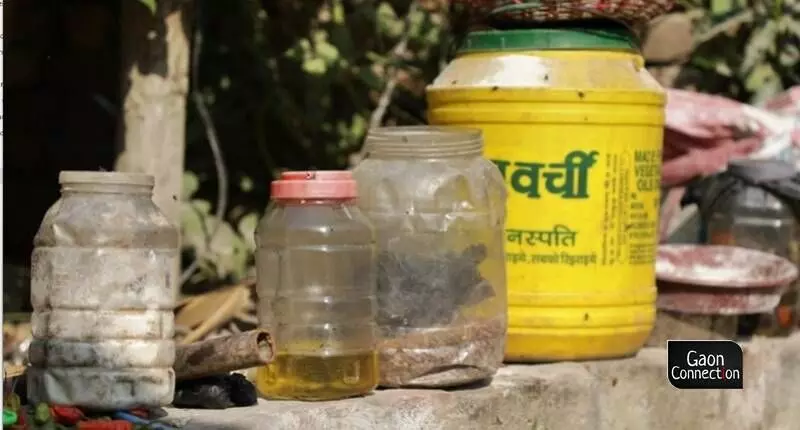
Similar concerns were raised by Lakshmi’s husband. “I cannot sustain selling batasa (panipuri snack) at the present prices. I used to sell aath (eight) batasas for ten rupees but now I cannot sell more than chheh (six) batasas for the same price,” Rameshwar said. “Nobody is even eating it anyway! I am constantly worried about the rising costs and falling income,” he added.
Almost 450 kilometres from Lakshmi Devi’s house, rural residents in the neighbouring state of Bihar fare no better. Sonu Gupta, a grocery shop owner from Bihar’s Devhaliya village in Kaimur district told Gaon Connection that customers are suspicious of him due to the high prices.
“The refined oil was being sold at one fifty rupees (Rs 150) per litre almost two weeks back. Now the price is above one hundred and seventy (Rs 170 a litre). The prices are rising on a daily basis,” the shopkeeper said. “I tell people that the prices are rising and I am not charging them extra but they find it hard to believe that prices can rise at such frequency,” he added.
Right next to Yadav’s eatery is a grocery shop run by 30-year-old Jeet Naag. He informed that earlier people used derivatives of vegetable oils as mustard oil was more expensive.
“But now there’s no price difference anymore and the prices are rising on a daily basis. The entire supply chain is facing inflation. It is because of the Ukraine war, people say,” Naag said.
As on March 15, a litre of mustard oil was being sold at Rs 192 while the refined vegetable oil’s cost was Rs 178 per litre.
About 350 kilometres away from Naag’s shop, Shashikala Gupta also runs a grocery shop in Varanasi’s Bhitari village. She told Gaon Connection that almost every essential commodity is getting costlier every day and it has adversely affected her sales.
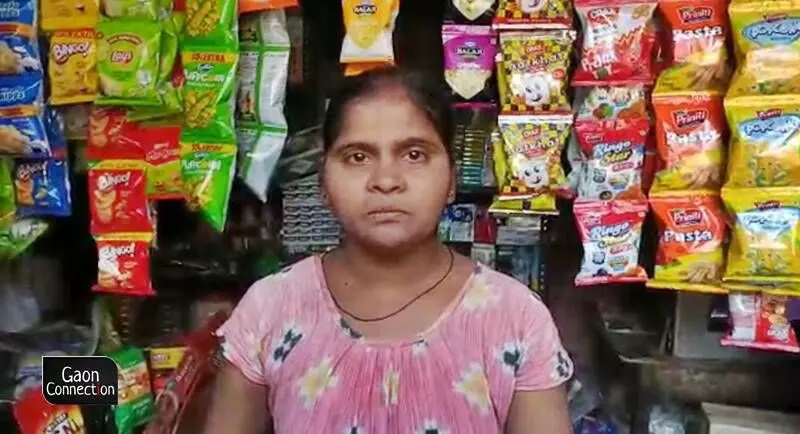
Shashikala Gupta
“People buy far less when the price is high as they have to buy keeping their budgets in mind. The people’s incomes haven’t increased, it is just the prices that have shot up. My sale is dwindling because of inflation,” Gupta told Gaon Connection.
“Apart from being a shopkeeper, I am also a mother and have to ensure the household expenses are met. I am facing a dual challenge from the shop as well as my household,” she added.
Gupta’s opinion about the price rise was echoed by a teacher who teaches at a private school in Unnao district’s Hadha village.
“My family of two children and my wife depend entirely on my salary as a school teacher. I barely manage to afford the monthly expenses ever since the prices of food commodities have increased for almost a month now,” 42-year -old Sanjay Pandey told Gaon Connection. If the prices rise any further I will find it very difficult to ensure two square meals for my family. If the inflation continues, most of the people in the country will find it difficult to even afford dal-roti (lentils and bread),” he said.
Food inflation on the rise
The collective anxieties of these rural citizens reflect in the Consumer Price Index (CPI) data published by the Union government. The latest data on inflation published by the Union Ministry of Statistics and Programme Implementation shows that the CPI for the month of February 2022 had soared to 6.07 per cent.
While formulating the monetary policy of the country for a fiscal year, the Reserve Bank of India (RBI) roughly estimates the CPI to hover around four per cent with an extended room for two per cent (six per cent in total). The spike in CPI was chiefly due to the high food inflation, which soared to 5.43 per cent.
In the wake of the CPI crossing the six per cent threshold in January 2022, the RBI Governor Shaktikanta Das told the press that there was no need to worry as the central bank is ready to face any challenge of inflation.
“Today’s inflation print is expected to be around 6 per cent. So that should not surprise or create any alarm, because we have taken that into consideration,” Das said on February 15, a day after the official announcement of the CPI breaching the six per cent mark.
Meanwhile, Finance Minister Nirmala Sitharaman also stated on February 28 that the war in Ukraine will have an impact on the economy.
“It (Ukraine conflict) will certainly have an impact on Indian economy… As regards to what is going to have a bearing on our immediate imports and equally on our exports to Ukraine, we are rightly worried about what comes from there. But I am more worried about what will happen to our exporters who are doing very well, particularly to the farming sector,” Sitharaman was quoted.

Source: Union Ministry of Commerce and Industry
‘Dependence on edible oil imports hurting economy’
BV Mehta of the Solvent Extractors’ Association of India told Gaon Connection that India’s demand for edible oils is mostly supplied by foreign countries and any geopolitical or economic complications faced by those countries is set to have a direct impact on the Indian consumer whose eating habit includes generous quantities of edible oils.
As per the industry data compiled by association, sunflower oil occupies nine per cent of the edible oil demand in the country.
“Almost 65 per cent of India’s sunflower crude oil is imported from Ukraine, which is presently facing the onslaught of the Russian invasion. Another 25 per cent of this supply comes from Russia and some eastern European countries and 10 per cent is imported from Argentina,” the industry expert told Gaon Connection. “As long as we do not find another supplier and the situation in Ukraine doesn’t get favourable for economic activities, it is obvious for the prices of edible oil to rise in India,” he added.
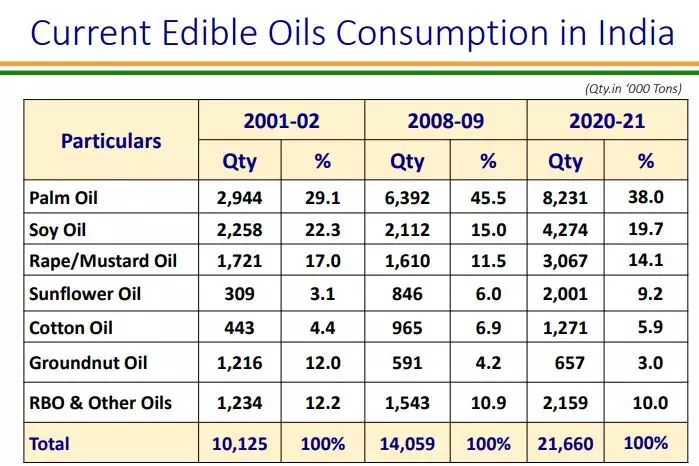
Source: Solvent Extractors’ Association of India
Last week on March 9, Union Finance Minister Nirmala Sitharaman told the press during an event in Bengaluru that India is presently exploring suppliers of sunflower oil from other countries to fix the shortfall in supply.
“We have already started looking at various other places from where any other edible oil, which is used in India, if not sunflower oil, can be imported,” the finance minister was quoted.
As per a press statement issued by the Union Ministry of Commerce and Industry on February 7, 2020, India needs 25 million tonnes of edible oils to meet its requirement at current consumption level of 19 kilogrammes per person per year.
“Out of the total requirement, 10.50 million tonnes is produced domestically from primary (soybean, rapeseed & mustard, groundnut, sunflower) and secondary sources (oil palm, coconut, rice bran, cotton seeds & tree borne oilseeds) and remaining 60%, is met through import,” the statement mentioned.
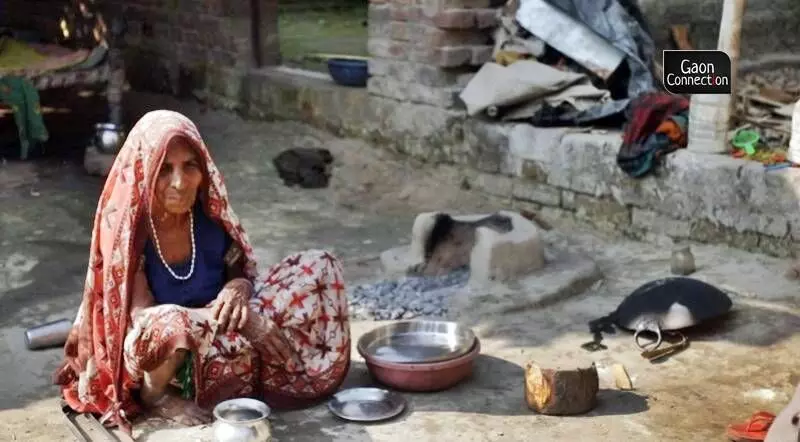
As per a press statement issued by the Union Ministry of Commerce and Industry on February 7, 2020, India needs 25 million tonnes of edible oils to meet its requirement at current consumption level of 19 kilogrammes per person per year.
Pramod Rai, the director of the Bharatpur (Rajasthan)-based Directorate of Rapeseed-Mustard Research of the Indian Council of Agricultural Research told Gaon Connection that there is a desperate need in the country to increase the production of oilseeds so as to cut down the dependence on imports.
“We need more investment and introduction of technology to ensure that we can meet our domestic demand for edible oil by ourselves. It will save a lot of foregn exchange money in the country. We are presently researching on the measures to increase the productivity of the oil seeds per hectare,” Rai told Gaon Connection.
With inputs from Virendra Singh in Barabanki (Uttar Pradesh), Sumit Yadav in Unnao (Uttar Pradesh), and Ankit Singh in Varanasi & Kaimur (Bihar).







